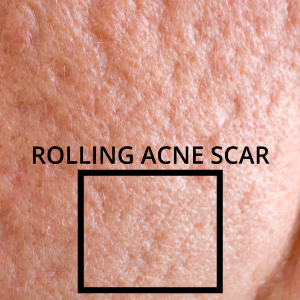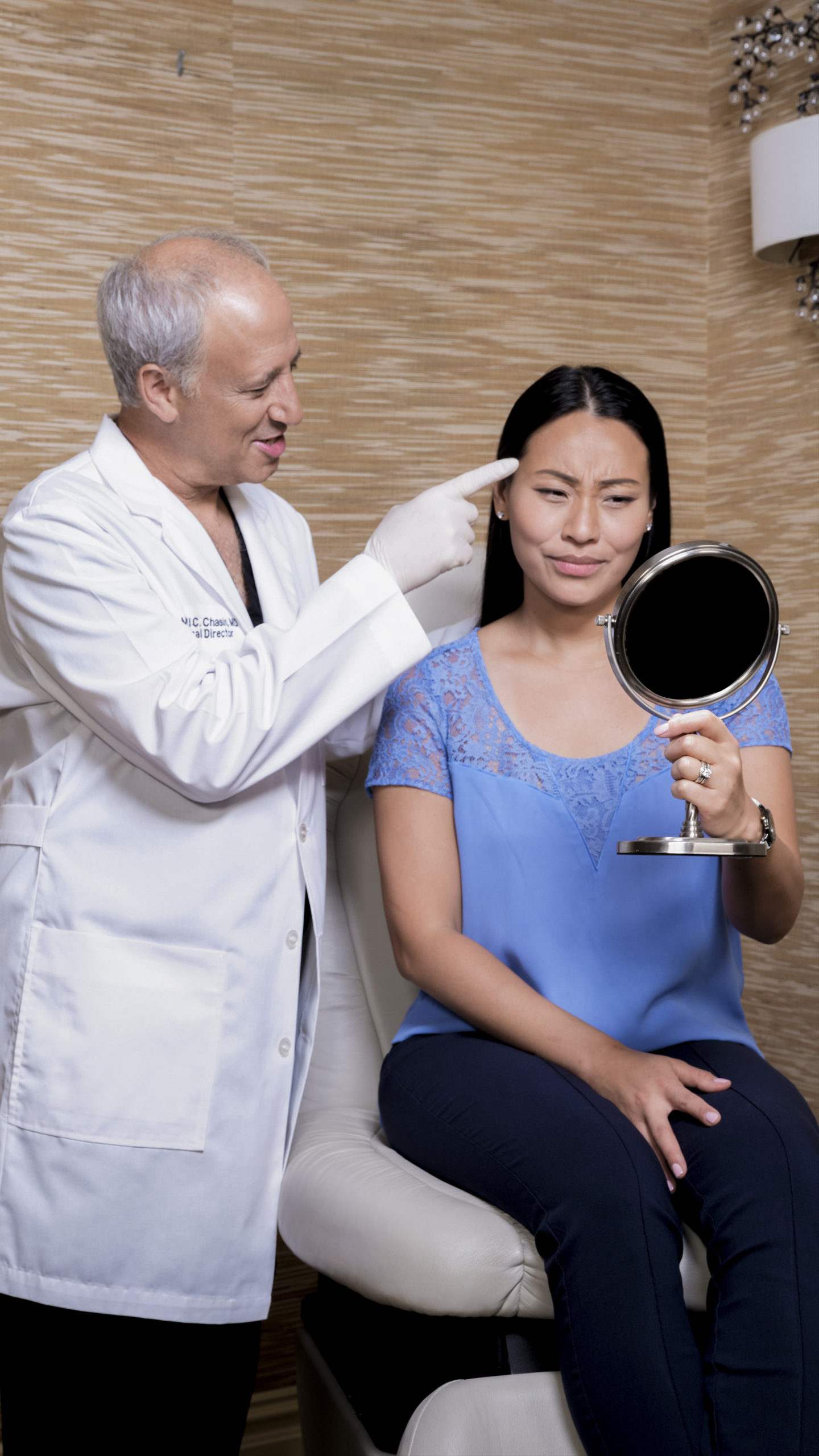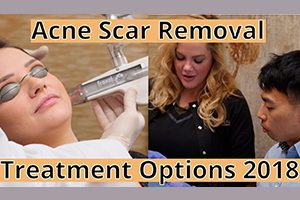Breakouts can come and go, but the damage it leaves behind can leave life-long scars that worsen as we age. If you are dealing with acne scars and are unhappy with the damage they have caused to your complexion, Reflections offers a wide array of treatment options to help restore clear, smooth skin.
Top Asked Questions About Acne Scarring
- What causes acne scars to form?
Cystic acne is often the culprit behind the worst cases of acne scarring we see, but even patients with only occasional or mild breakouts can experience severe acne scarring. This is particularly true when active acne is picked, squeezed, or popped, creating further damage to the surrounding skin and tissues. Cystic acne affects tissue deep in the skin and occurs when clogged pores become filled with pus and bacteria. Inflammation in the pore can destroy collagen support and the normal fat layer just below the skin, creating pitted and indented scarring. As the body heals the acne pimple, it lays down scar tissue. This is a normal response by the body to try to make the area stronger than before. However, this scar tissue often leaves a thick, uneven skin surface. When the scar tissue attaches to both the top layer of the skin and the fascia below, the skin gets tethered down into an indented scar – ice pick, boxcar, or rolling scars are created this way.
- What can worsen acne scars?
Too much sun can darken acne scarring. Also, picking, scratching, and squeezing your skin can promote inflammation, making scars worse.
- What does acne scarring look like?
Acne scarring ranges in appearance from mottled, shallow depressions to deep and narrow depressions.
- Do acne scars get worse with age?
Aging can make acne scars appear worse because collagen begins to break down with time, resulting in volume loss and skin laxity. This is especially true for depressed acne scars and atrophic scarring.
- Do acne scars ever fully heal?
The appearance of acne scars can be faded, but it can take dedicated treatment to get good results. Treating them early is the best way to see progress – in fact, the worst thing you can do with acne scars is leave them untreated. We recommend seeing a cosmetic physician as soon as possible if you want to treat acne scars.
- How do you know if acne scars are permanent?
Some types of acne scars will go away on their own or with minimal treatment. If acne scars are still visible within several months, they are likely to remain visible for the long term.
- What is the hardest acne scar to remove?
Acne scars that produce texture are some of the hardest types to treat. That is, scars like keloids or icepick scars. These types of acne scars require significant knowledge of skin rejuvenation and available technologies to produce good results.
- What type of acne scars are permanent?
Scars caused by severe acne are most likely to be permanent. These types of scars tend to produce texture that remains long after the skin has healed. As with any type of acne scar, they’re best treated early on.
What Are the Types of Acne Scars -and Why Does It Matter?

Rolling Acne Scars
Rolling acne scars are characterized as broad depressions in the skin with rounded, sloping edges. When there are a number of these scars in the same region, it gives the skin a rolling appearance. These types of scars are common in people who have been afflicted by long-term inflammatory acne (cystic acne) and become more pronounced as the skin ages.

Boxcar Acne Scars
Boxcar acne scars are broad, box-shaped depressions that have deep, defined edges. They often resemble chicken pox scars. Because the edges of boxcar scars are deeper and steeper than those of rolling scars, it is harder to blend them into surrounding skin. These scars are caused by the breakdown of collagen and tissue in the skin by inflammation.

Ice Pick Acne Scars
Ice pick acne scars are deep and narrow and resemble a large, empty pore. As the name suggests, it can look as though the skin has been punctured with an ice pick. When the body doesn’t produce enough collagen due to an injury (like severe acne), depressions such as ice pick scars can form. This type of acne scarring is often the most difficult to treat.

Dark Spots & Red Acne Scars
Acne often leaves behind red or dark spots, especially for patients with Hispanic, Asian, African, and/or Middle Eastern/Mediterranean heritage(s). These skin types are more prone to pigment changes in general and acne often leaves discoloration that is very difficult to remove on skin types 3-6. Our physicians understand how frustrating this discoloration can be and how carefully it must be treated. Many traditional acne scar treatments, such as certain lasers, are either not suitable for these skin types or must be turned down to such a low-power setting that the treatments are not very effective. That’s why our practice has invested heavily in a variety of treatments, including those that best treat our patients with sensitive skin.
Treatments for Each Type of Acne Scar
Because acne scarring is due to collagen damage in the deeper layers of skin and irregular scar tissue in the skin’s support layers, repairing this damage can create a smoother skin appearance. There are two ways we can treat firm, misshapen acne scars:
Break Up Scar Tissue
We can break up the scar tissue and release the tethers, stimulate the body to lay down new healthy collagen support in that area, and replace the missing fat volume to support the skin from below and create a smooth surface. This is the recommended treatment since it is less invasive and there are a variety of options to smooth your acne scars.
Surgical Excision
We can remove the scar completely using surgical excision – this is typically reserved for the very worst of these scars.
Acne scars disrupt the normal fat layer that exists just below the skin. Aging also sees this layer continue to deteriorate. That’s why acne scars often appear to get worse over time, especially in our late 40s and beyond. Whenever volume is needed, there are 2 main options for replacing it: fat transfer and dermal fillers.
Fat Transfer
A fat transfer removes fat from your love handles or abdomen and transfers it to wherever you need it most. This procedure offers very natural and long-lasting results because we’re making use of your own fat cells.
Dermal Fillers
Dermal fillers come in a variety of brands and types and are injected to replace lost volume. We offer all of the best and most well-known dermal fillers including Juvederm, Radiesse, Restylane, Voluma, and more! These are very precise, quick, and easy treatments.
Deep acne lesions will cause significant damage to the collagen support of the skin. As we age and lose more collagen, our skin will continue to thin and these gaps in the support below the skin will become more obvious. Luckily, there are many proven treatments that will stimulate your body to grow its own new, healthy collagen.
Lasers & Microneedling
Lasers and microneedling work by creating tiny columns of microdamage which the skin responds to by laying down more collagen in the area, to fortify the skin. Radiofrequency and ultrasonic energy work by heating up the collagen bundles, causing them to be completely remodeled and repaired by the body. RF (radiofrequency) microneedling combines both radiofrequency heat and deep microneedling, making it one of our favorite ways to treat acne scars because of the big results it creates.

View More Acne Scarring Treatment Before & Afters
More Before & Afters

Why Trust Reflections to Help You Repair the Damage of Acne Scarring?
Acne scarring can happen to anyone of any skin tone, and can negatively impact many people’s self-esteem and confidence. Thankfully, there are now a number of effective acne scar treatment options to help you look and feel more like yourself.
At Reflections, we employ a holistic view of acne scars and tools to treat each of the underlying causes at the source for healthy skin that ages beautifully. No matter what type of acne scars you have, our doctors can create a customized plan to address your current acne scars and also prevent future scarring.
We also believe that your acne scars deserve to be treated by a doctor, which is why each of our patients will see a skilled physician when they come in for their consultation appointment. We aim to provide our patients with the best possible care for optimal results.
If you are ready to take the first step toward smoother, more even skin texture and tone, contact Reflections Center today. We will be happy to schedule your free consultation appointment with one of our physicians.

Blog
8 Types of Acne Scars
Breakouts can be frustrating for many reasons, but there are fewer things more...
Read More
Blog
Acne Scar Treatment: What Dermatologists and Plastic Surgeons Can’t Do
Acne scarring is famously hard to get rid of. If it gets in the way of your...
Read More
Blog
Shedding some (laser) light on acne scar removal
Major acne can leave painful reminders in the form of deep acne scars. Not long...
Read MoreSchedule Your Free Consultation
With One Of Our Physicians
Schedule Now

Dr. Mitchell Chasin is a Cosmetic & Laser Physician at Reflections Center. Dr. Chasin believes strongly that the best cosmetic physicians are those who are dedicated to mastering their craft through continuing education and collaboration with the industry’s top doctors.














